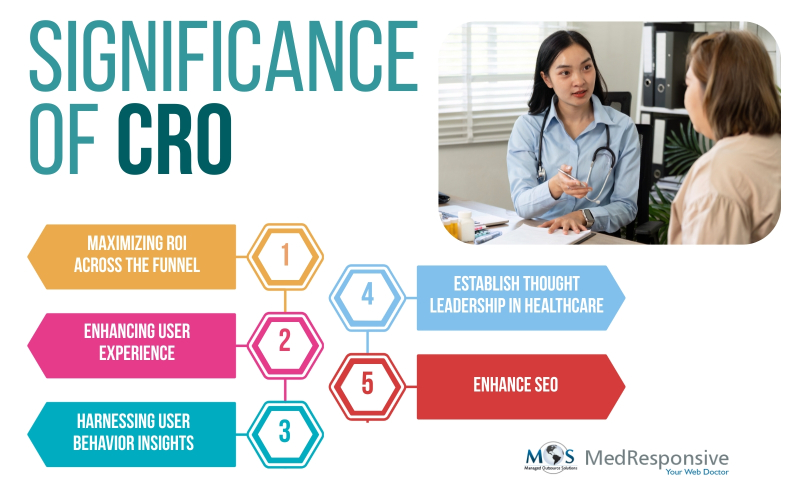The world is shifting from analogue to digital and this has led to a drastic increase in digital marketing for businesses. It helps in getting a custom strategy that will work to improve traffic and page ranking. But now it is no longer just about driving more visitors, it’s about increasing website conversions.
Online medical marketers now realize that in order to increase sales and revenue, medical businesses have to optimize the visitor’s onsite experience and convert potential customers to actual customers. This process is known as conversion rate optimization (CRO). It is a system for increasing the percentage of visitors to a website that converts into customers or takes any desired action on the webpage. CRO integrates copywriting, visual design, psychology, user experience optimization, and other elements that influence decisions.
Professionals at a custom website development service take psychology and behavioral components of visitors into consideration when designing conversion optimization strategies. By understanding why users make specific choices, they help businesses design experiences that encourage conversions.
Studying customer behavior provides valuable insights into how to improve website conversion rate effectively, resulting in measurable growth and long-term digital success.
Now let us look at some of the CRO facts.
Understanding Conversion Rate Optimization
Four Essential Components of CRO
- Call to action: This is the primary button or link or other user interface element that users can use to take action that leads to a conversion. A “buy now” button on a commercial website, or a “sign up” button on an email registration field, a “download now” request etc. are some examples of call to action.
- Conversion funnel: It is the primary pathway of the user experience where visitors complete a conversion.
- A/B or Split testing: It is a tool that measures each element by its effectiveness and helps you discover which variation of your website converts more visitors into leads.
- Multivariate Testing: It helps to determine the best performing elements and combinations.
The conversion rate will vary depending on the type of website, and your specific goals.
- For an e-commerce website a conversion occurs when a purchase is completed by a visitor.
- For a services website such as one for healthcare businesses, a conversion occurs when a signup/form has been completed by a visitor.
- For a blog/media website, a conversion occurs when a newsletter or some other opt-in has been completed by a visitor.
How to Measure Conversion Rate Optimization
Metrics for Calculating Conversion Rate
- Bounce rate: It refers to the percentage of people who leave after viewing a single page. A high bounce rate is not favorable for any website.
- Exit rate: It is the percentage of people who leave after viewing the page. This will let you know the last page that users view before they move on. A high exit rate is also not favorable for any website.
- Average time onsite: This helps in knowing how long users stick around on your website. A high bounce rate means a low average time on site.
- Average page views: It tells you how many pages the average visitor browsed before leaving. More page views mean engagement but also means a lack of clarity in your conversion funnel.
How to Calculate Conversion Rate
Calculating your conversion rate is simple:
For example, if your site had 20,000 visitors and 500 conversions last month, the rate would be (500 ÷ 20,000) × 100 = 2.5%.
The formula can vary depending on your business model:
- E-commerce sites: Use total sessions since users can convert multiple times. Two purchases across three visits count as two conversions in three sessions.
- Subscription-based sites: Use unique visitors since each user can convert only once. Multiple visits by the same person still count as one conversion.
Keep in mind that conversion rates differ by industry and goal, landing pages may see around 23% for sign-ups while e-commerce averages 2–3%. Understanding the importance of CRO in digital marketing means realizing it’s not about small tweaks. It’s about streamlining the user journey to turn your website into an efficient, results-driven conversion engine.
Why Conversion Optimization Matters
- Maximizing ROI across the Funnel
With rising competition and ad costs, CRO ensures you gain more value from existing visitors by boosting the percentage who take action. This leads to a lower cost per acquisition and higher returns from your marketing spend. Rather than relying solely on increased traffic, CRO focuses on turning current users into customers, making your strategy more efficient and sustainable.
- Enhancing User Experience
CRO eliminates barriers that prevent users from converting, such as slow loading, poor navigation, or unclear messaging. By reducing friction, it creates a smoother and more engaging experience that encourages users to take action, return, and recommend your brand. A positive experience not only improves conversions but also builds long-term loyalty.
- Harnessing User Behavior Insights
Analyzing user behavior—like clicks, scroll depth, and drop-off points—reveals what engages visitors and what doesn’t. These insights guide improvements beyond CRO, benefiting digital marketing, product design, and customer support. Over time, this data-driven understanding strengthens overall business strategy.
- Boosting Conversions without Extra Traffic
A higher conversion rate translates directly into more leads or sales without increasing traffic. For instance, improving from a 2% to a 3% conversion rate on 100,000 visitors adds 1,000 more conversions, a 50% increase without additional ad spend. CRO is, therefore, one of the most cost-effective methods for growth.
- Working Hand-in-Hand with SEO and SEM
CRO complements, not replaces, traffic-generation tactics like SEO and paid search. While SEO brings visitors in, CRO ensures those visits lead to action. Moreover, CRO-driven improvements such as faster site speed, responsive design, and clearer messaging, can boost SEO performance, creating a powerful feedback loop that attracts better traffic and drives more conversions.
Today, advanced digital marketing tools are available that can help to identify what vibes with your specific list of current and prospective clients. Every step you take to substantially improve your conversions can also increase your return on your web marketing investment. You need to work regularly to increase conversions and focus on the efforts that prove to be the best.
Healthcare businesses can use digital marketing services for healthcare to learn more about CRO and how to get good results quickly.
Strategic CRO efforts will generate more leads or sales on your website with your existing traffic, help maximize the ROI from your marketing spend on paid search, social media search, and so on. It will enhance your website so that it engages more visitors, and increase the chance of returning visitors. CRO will give you a competitive advantage over competitors who may not be using it strategically.
Case Study: Interplay Learning Increased Conversion Rate by 183%
Interplay Learning wanted to better understand how users interacted with key web pages such as pricing, demo sign-up, and educational content, to convert more visitors into qualified leads. While analytics tools provided quantitative data like bounce rates and session times, the team needed deeper insights into user behavior.
Partnering with a web development service, they used dynamic heatmaps and session recordings to identify friction points and optimize page layouts. One key change, hiding visible pricing on the pricing page, led to a conversion rate jump from 6% to 17% for demo sign-ups. User interaction data also revealed which plans attracted more clicks, guiding improvements to calls-to-action and interactive elements.
By sharing these behavioral insights across marketing and sales, the company achieved stronger alignment, faster UX improvements, and sustained performance growth.
Key Results:
- 183% increase in demo page conversions
- Basic plan clicks: 12% → 25%
- Teams plan clicks: 8% → 20%
- Enterprise plan clicks: 1% → 3%
- Improved collaboration between marketing and sales
- Faster detection of UX issues through behavior analysis
Today, advanced digital marketing tools make it easier to understand what resonates with your current and potential clients. Every improvement you make to boost conversions also enhances the return on your overall marketing investment. To achieve consistent growth, it’s important to continually refine strategies and focus on tactics that deliver measurable results.
Healthcare businesses can leverage expert solutions provided by a custom website development service to strengthen their online performance. These professionals can help implement effective CRO strategies that drive more leads or sales from existing traffic, maximizing ROI from paid search, social media, and other marketing channels.
By optimizing design, navigation, and user experience, CRO ensures your website attracts, engages, and retains more visitors, giving you a clear competitive edge over businesses that aren’t utilizing it strategically.





